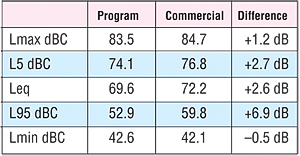When the Ad's Audio Annoys

Last month, I got a nice letter from reader Gene Karlin, who wanted to rant about the levels of commercials, which he finds offensive. He makes the entirely reasonable case that some producers of commercials don't understand that by jacking up the loudness of the commercial vis-à-vis the program, they simply encourage us to mute or turn down the level with our trusty remotes. Such responses on our part (in psychology, we call this "aversive response behavior") do not work in the best interests of the advertiser (aka "paying client"). Hmmmm. Worth thinking about.
In my recent rants about levels and loudness, I haven't devoted any ink to intentional production excesses that are undertaken for enhanced editorial effect. It doesn't seem to me like it's my business to tell them, from my lofty station as audio journalist/guru, how to do their audio. It's their call, not mine.
But Gene's letter got me to wondering, why not? Why shouldn't I have an opinion? Am I not an audio guru? (don't answer that).
ABOUT TV COMMERCIALS
Keep in mind, those commercials have almost nothing to do with me. Last month, for instance, watching my beloved New England Patriots miss the NFL playoffs, I kept approximate track of the commercials and found that maybe one out of about 30 involved anything that I might possibly be interested in buying. For instance, there's no way, at my age and with my health (both classified), that I am going to have any interest in a Subway Footlong Sub. And the advertisers have to know this. I suspect I'm viewed as a freeloader, unavoidably inefficient—a wasted viewer. Fortunately for them, I'm easy to ignore, while naturally I ignore them right back—I have no interest in what they want to sell.
More to the point, the advertisers' pitches seem to target the 20- to 50-year-old lower middle class, using sales arguments of cheap, exciting, macho, bling, sexy, funny, cute, lovable and clever, while glossing over issues of complexity, reliability, suitability, value and quality.
To be successful, such advertising has to grab viewers' attention and hold it, be effective even when the audio is muted (and in fast-forward), be entertaining and as interesting (they hope) as the program it is supporting. Oh yes, and hint at everything while actually promising absolutely nothing.
INFORMAL ASSESSMENT
So, in the interest of science, I did some informal level measurements of the acoustic levels of commercials versus programs. I chose a half-hour national major network news program and took noise level histories of the program segments and also the commercial segments. The results are interesting, if not terribly dramatic.
The newscast program segments played back at an Leq (the power-based average of the entire file) of 69.6 dBC SPL, with a peak level (Lmax) of 83.5 dBC SPL and an L95 (level exceeded 95 percent of the time) of 52.9 dBC SPL.
The commercial segments played back about 3 dB louder than the program, with an accumulated Leq of 72.6 dBC SPL, an Lmax of 84.7 dBC SPL and an L95 of 59.8 dBC SPL.
What's most revealing was the L95 measurement, with a 7 dB increase from program to commercial. L95 represents the approximate minimum level of the audio (as opposed to the noise floor of the room during periods of no audio), and it's clear that our advertisers are going to keep those low levels ticking over a good bit louder than the program audio mixer does.
However, it is worth noting that, to my ears, none of the commercials had outrageous audio. None of them were hypercompressed, or offensively bright or bass-heavy. They were noticeably louder than the newscast, but not offensively so. See Table 1, showing the details for your edification.

Table 1: Results from informal level measurements of the acoustic levels of commercials versus programs. The microphone was at the preferred listening position, and all speakers were calibrated so that Pink Noise at –14 dBFS yielded 85 dBC SPL at the listening position. Obviously, the analog audio levels from the set-top box were at some softer level, but all five main channels were at the same level, and the LFE channel was 10 dB down and distributed to LCR (I don't have, or need, a separate subwoofer).
WHAT A DIFFERENCE
To the extent that the commercials and their audio are typical, and that, similarly, the program production values are normal (I personally think they were, in this case), this is pretty benign stuff. There may be problems for some set-top boxes with dynamic range control invoked, especially if dialnorm is not set correctly. Further, there is an obvious generic difference between the audio for commercials and the audio for programs, which is probably as it should be.
Some commercials are offensive for their hyped-up in-your-face quality. Such commercials are not usually encountered as part of "the evening news." I suspect that on the Speed Channel, or the kind of channel that specializes in World Wrestling Entertainment and related sports mayhem, we may encounter commercials that are a lot, ah, perkier.
Here, the commercials were just time-wasters, for products and services that I've no need for nor interest in, even though "the evening news" might be expected to attract doddering old fools like me more than younger, more aspirational folks dedicated to "stuff" more than I am.
It was weird, making the measurements, to fast-forward through the program segments looking for commercials. Yikes!
Next month, I'll review where we are with channel-to-channel levels, in anticipation of the great digital switchover looming on the horizon.
Thanks for listening.
Dave Moulton is trying to remember the last time he paid attention to a commercial. You can complain to him about anything at his Web site,www.moultonlabs.com.
The professional video industry's #1 source for news, trends and product and tech information. Sign up below.

